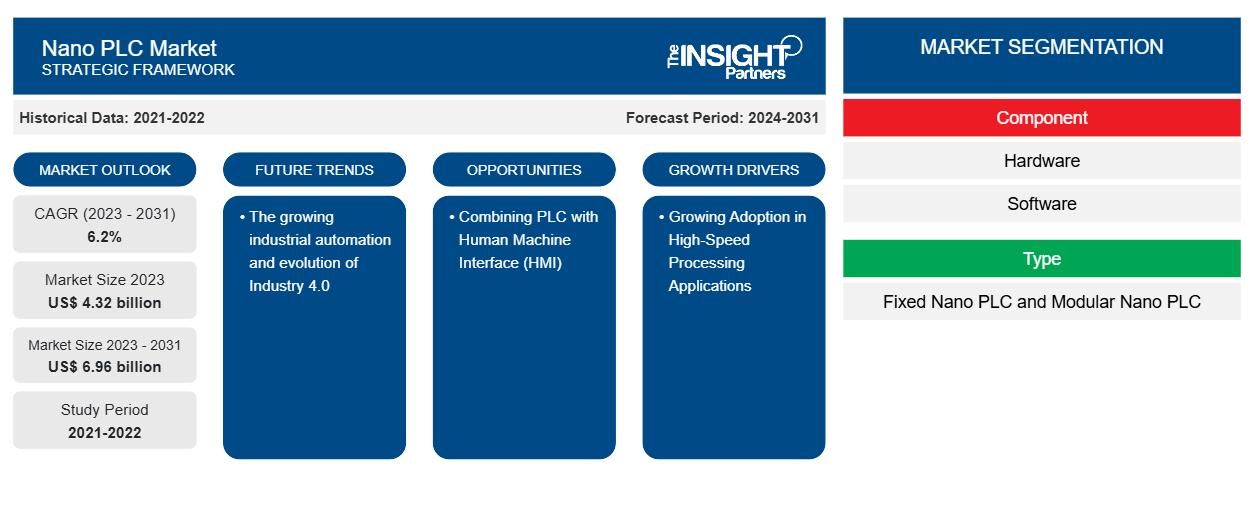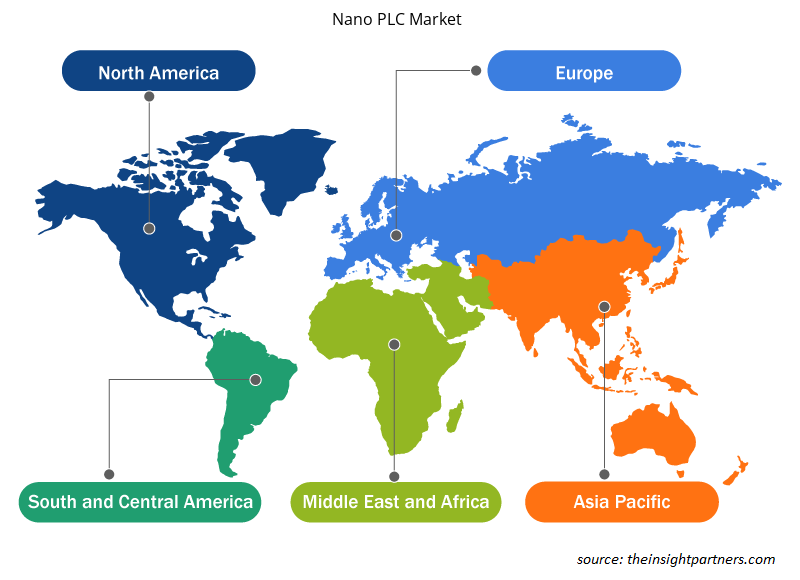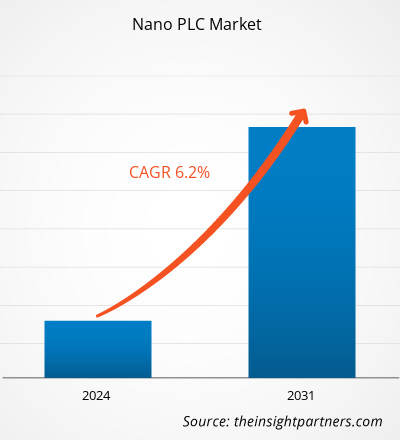The nano PLC market size is projected to reach US$ 6.96 billion by 2031 from US$ 4.32 billion in 2023. The market is expected to register a CAGR of 6.2% in 2023–2031. The growing industrial automation and evolution of Industry 4.0 and are likely to remain a key nano PLC market trends.
Nano PLC Market Analysis
The nano PLC market is growing at a rapid pace due to the growing adoption of high-speed processing applications, rapid industrialization, and increasing usage of automatic security systems. The market is expanding steadily, driven by the growing demand for smart manufacturing. Moreover, combining PLC with human-machine interface (HMI) and the rising adoption of technologically advanced solutions such as IoT lighting is providing lucrative opportunities for market growth.
Nano PLC Market Overview
Nano PLCs are controller devices that improve industrial control systems by improving adaptability and lowering complexity. Nano PLCs can improve and optimize industrial processes, which increases their adoption among industries. In today's industrial environments, the competitive and technological landscapes are rapidly evolving. The demand for large industrial automation surged the adoption of Nano PLCs to perform tasks by improving productivity and cost savings. Moreover, the growing demand for flexible automation solutions among industries is boosting the market during the forecast period.
Customize This Report To Suit Your Requirement
You will get customization on any report - free of charge - including parts of this report, or country-level analysis, Excel Data pack, as well as avail great offers and discounts for start-ups & universities
Nano PLC Market: Strategic Insights

- Get Top Key Market Trends of this report.This FREE sample will include data analysis, ranging from market trends to estimates and forecasts.
You will get customization on any report - free of charge - including parts of this report, or country-level analysis, Excel Data pack, as well as avail great offers and discounts for start-ups & universities
Nano PLC Market: Strategic Insights

- Get Top Key Market Trends of this report.This FREE sample will include data analysis, ranging from market trends to estimates and forecasts.
Nano PLC Market Drivers and Opportunities
Growing Adoption in High-Speed Processing Applications is Driving the Market
Nano PLCs are very compact solutions that include standard functions which are easy to set up. The compact size of nano PLC increases its adoption among high-speed processing applications and control systems that require counting capacity or short response times. Nano PLCs are highly capable of working at different types of short response times, including fast counter (maximum frequency 10 kHz), fast up/down counter (maximum frequency 1 kHz), and frequency meter (maximum frequency 10 kHz). Moreover, significant benefits offered by nano PLC to high-speed applications include the availability of battery backup, PID loops for control systems applications, unlimited write retentive memory, and a cost-effective replacement for traditional solutions. However, nano PLC offers flexibility with easy controlling and handling of complex processing applications boosting the market during the forecast period.
Combining PLC with Human Machine Interface (HMI) - An Opportunity in the Nano PLC Market
Today's HMIs are highly capable of performing many of the functions that were formerly performed and handled by control systems, including actual machine control and I/O processing from sensors and machines. The mixing of functions has resulted in the creation of HMI-PLC combo units. The combination is a natural extension of an ongoing trend, as PLCs have some form of basic interface, and HMIs have increasingly evolved to provide more fundamental control capabilities. The combination of HMI-PLC units is making industrially hardened devices into a single housing. This combination functions as a web server and typically offers significant benefits to the users in setting alarms, graphing, data logging, and monitoring trends, with multiple control functions, which increases its adoption among industries. HMI-PLC unit units support industries in reducing operational complexities and decreasing development time by lowering overall operational costs are expected to create opportunities in the market during the forecast period.
Nano PLC Market Report Segmentation Analysis
Key segments that contributed to the derivation of the nano PLC market analysis are component, type, and industry.
- Based on component, the nano PLC market is divided into hardware and software. The hardware segment is further subsegmented into processor, power supply, input/output (I/O), and other hardware. The hardware segment held a larger market share in 2023.
- On the basis of type, the nano PLC market is divided into fixed nano PLC and modular nano PLC. The fixed nano PLC segment held a larger market share in 2023.
- In terms of industry, the nano PLC market is categorized as automotive, energy & power, home and building automation, oil & gas, pharmaceuticals, metals & mining, and other industries. The automotive segment held a larger market share in 2023.
Nano PLC Market Share Analysis by Geography
The geographic scope of the nano PLC market report is mainly divided into five regions: North America, Asia Pacific, Europe, Middle East & Africa, and South America/South & Central America.
In terms of revenue, the North America market accounted for the largest nano PLC market share, due to the growing automation and high adoption of technologically advanced products. Increasing focus on research activities to develop high-end nano PLCs is creating opportunities in the market.
The market in Asia Pacific is projected to expand during the forecast period, due to the expanding numerous industries such as automotive, energy & power, oil & gas, and others. These industries are using nano PLC for adopting smart manufacturing processes is driving the market. Moreover, increasing government initiatives to promote automation projects and the growing number of infrastructural development activities are boosting the market in Asia Pacific.
Nano PLC Market Regional Insights
The regional trends and factors influencing the Nano PLC Market throughout the forecast period have been thoroughly explained by the analysts at Insight Partners. This section also discusses Nano PLC Market segments and geography across North America, Europe, Asia Pacific, Middle East and Africa, and South and Central America.

- Get the Regional Specific Data for Nano PLC Market
Nano PLC Market Report Scope
| Report Attribute | Details |
|---|---|
| Market size in 2023 | US$ 4.32 billion |
| Market Size by 2031 | US$ 6.96 billion |
| Global CAGR (2023 - 2031) | 6.2% |
| Historical Data | 2021-2022 |
| Forecast period | 2024-2031 |
| Segments Covered |
By Component
|
| Regions and Countries Covered | North America
|
| Market leaders and key company profiles |
Nano PLC Market Players Density: Understanding Its Impact on Business Dynamics
The Nano PLC Market is growing rapidly, driven by increasing end-user demand due to factors such as evolving consumer preferences, technological advancements, and greater awareness of the product's benefits. As demand rises, businesses are expanding their offerings, innovating to meet consumer needs, and capitalizing on emerging trends, which further fuels market growth.
Market players density refers to the distribution of firms or companies operating within a particular market or industry. It indicates how many competitors (market players) are present in a given market space relative to its size or total market value.
Major Companies operating in the Nano PLC Market are:
- Crouzet Automatismes SAS
- Emerson Electric Co.
- EZAutomation
- Keyence Corporation
- Mitsubishi Electric Corporation
- OMRON Corporation
Disclaimer: The companies listed above are not ranked in any particular order.

- Get the Nano PLC Market top key players overview
Nano PLC Market News and Recent Developments
The nano PLC market is evaluated by gathering qualitative and quantitative data post primary and secondary research, which includes important corporate publications, association data, and databases. The following is a list of developments in the market for nano PLC and strategies:
- In April 2024, French firm Crouzet chose Bangalore’s Aerospace and Defence Park to establish its new factory to produce mechatronic components for both the Indian and international markets. (Source: Embassy of France in India, Press Release, 2024)
Nano PLC Market Report Coverage and Deliverables
The “Nano PLC Market Size and Forecast (2021–2031)” report provides a detailed analysis of the market covering below areas:
- Market size and forecast at global, regional, and country levels for all the key market segments covered under the scope
- Market dynamics such as drivers, restraints, and key opportunities
- Key future trends
- Detailed PEST/Porter’s Five Forces and SWOT analysis
- Global and regional market analysis covering key market trends, major players, regulations, and recent market developments
- Industry landscape and competition analysis covering market concentration, heat map analysis, prominent players, and recent developments
- Detailed company profiles
Frequently Asked Questions
What is the estimated market size for the global nano PLC market in 2023?
The global nano PLC market was estimated to be US$ 4.32 billion in 2023 and is expected to grow at a CAGR of 6.2% during the forecast period 2023 - 2031.
What are the driving factors impacting the global nano PLC market?
The growing adoption of high-speed processing applications, rapid industrialization, and increasing usage of automatic security systems are the major factors that propel the global nano PLC market.
What are the future trends of the global nano PLC market?
The growing industrial automation and evolution of Industry 4.0 to play a significant role in the global nano PLC market in the coming years.
Which are the key players holding the major market share of the global nano PLC market?
The key players holding majority shares in the global nano PLC market are Crouzet Automatismes SAS, Emerson Electric Co., EZAutomation, Keyence Corporation, and Mitsubishi Electric Corporation.
What will be the market size of the global nano PLC market by 2031?
The global nano PLC market is expected to reach US$ 6.96 billion by 2031.
What is the incremental growth of the global nano PLC market during the forecast period?
The incremental growth expected to be recorded for the global nano PLC market during the forecast period is US$ 2.65 billion.
- Historical Analysis (2 Years), Base Year, Forecast (7 Years) with CAGR
- PEST and SWOT Analysis
- Market Size Value / Volume - Global, Regional, Country
- Industry and Competitive Landscape
- Excel Dataset
Testimonials
I wish to appreciate your support and the professionalism you displayed in the course of attending to my request for information regarding to infectious disease IVD market in Nigeria. I appreciate your patience, your guidance, and the fact that you were willing to offer a discount, which eventually made it possible for us to close a deal. I look forward to engaging The Insight Partners in the future, all thanks to the impression you have created in me as a result of this first encounter.
DR CHIJIOKE ONYIA, MANAGING DIRECTOR, PineCrest Healthcare Ltd.The Insight Partners delivered insightful, well-structured market research with strong domain expertise. Their team was professional and responsive throughout. The user-friendly website made accessing industry reports seamless. We highly recommend them for reliable, high-quality research services
Yukihiko Adachi CEO, Deep Blue, LLC.Reason to Buy
- Informed Decision-Making
- Understanding Market Dynamics
- Competitive Analysis
- Customer Insights
- Market Forecasts
- Risk Mitigation
- Strategic Planning
- Investment Justification
- Identifying Emerging Markets
- Enhancing Marketing Strategies
- Boosting Operational Efficiency
- Tracking Industry Innovations
- Aligning with Regulatory Trends
Yes! We provide a free sample of the report, which includes Report Scope (Table of Contents), report structure, and selected insights to help you assess the value of the full report. Please click on the "Download Sample" button or contact us to receive your copy.
Absolutely — analyst assistance is part of the package. You can connect with our analyst post-purchase to clarify report insights, methodology or discuss how the findings apply to your business needs.
Once your order is successfully placed, you will receive a confirmation email along with your invoice.
• For published reports: You’ll receive access to the report within 4–6 working hours via a secured email sent to your email.
• For upcoming reports: Your order will be recorded as a pre-booking. Our team will share the estimated release date and keep you informed of any updates. As soon as the report is published, it will be delivered to your registered email.
We offer customization options to align the report with your specific objectives. Whether you need deeper insights into a particular region, industry segment, competitor analysis, or data cut, our research team can tailor the report accordingly. Please share your requirements with us, and we’ll be happy to provide a customized proposal or scope.
The report is available in either PDF format or as an Excel dataset, depending on the license you choose.
The PDF version provides the full analysis and visuals in a ready-to-read format. The Excel dataset includes all underlying data tables for easy manipulation and further analysis.
Please review the license options at checkout or contact us to confirm which formats are included with your purchase.
Our payment process is fully secure and PCI-DSS compliant.
We use trusted and encrypted payment gateways to ensure that all transactions are protected with industry-standard SSL encryption. Your payment details are never stored on our servers and are handled securely by certified third-party processors.
You can make your purchase with confidence, knowing your personal and financial information is safe with us.
Yes, we do offer special pricing for bulk purchases.
If you're interested in purchasing multiple reports, we’re happy to provide a customized bundle offer or volume-based discount tailored to your needs. Please contact our sales team with the list of reports you’re considering, and we’ll share a personalized quote.
Yes, absolutely.
Our team is available to help you make an informed decision. Whether you have questions about the report’s scope, methodology, customization options, or which license suits you best, we’re here to assist. Please reach out to us at sales@theinsightpartners.com, and one of our representatives will get in touch promptly.
Yes, a billing invoice will be automatically generated and sent to your registered email upon successful completion of your purchase.
If you need the invoice in a specific format or require additional details (such as company name, GST, or VAT information), feel free to contact us, and we’ll be happy to assist.
Yes, certainly.
If you encounter any difficulties accessing or receiving your report, our support team is ready to assist you. Simply reach out to us via email or live chat with your order information, and we’ll ensure the issue is resolved quickly so you can access your report without interruption.





















 Get Free Sample For
Get Free Sample For